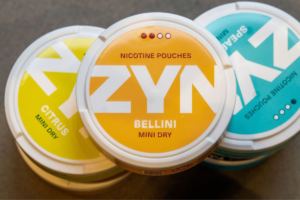Introduction to Low Dose Nicotine Pouches
Definition and Overview
Low dose nicotine pouches represent a novel category in the world of nicotine products. Unlike traditional tobacco products, these pouches do not contain tobacco leaf. Instead, they are filled with a blend of nicotine, flavorings, and plant-based materials. Designed to fit discreetly under the user’s lip, they offer a smoke-free, spit-free experience, making them an appealing option for those seeking an alternative to smoking or vaping.
Historical Evolution of Nicotine Pouches
The journey of nicotine pouches began as a response to the growing demand for safer nicotine alternatives. Originating in Sweden, these products have roots in the traditional Swedish ‘snus’, yet they evolved to be tobacco-free. Over the years, advancements in technology and a deeper understanding of consumer needs have transformed these pouches into sophisticated products. Experts like Dr. Lars Erik Rutqvist, a notable authority in tobacco harm reduction, emphasize the significance of these developments in offering reduced-risk alternatives to smokers.

Comparison with Traditional Nicotine Products
When compared to traditional nicotine products like cigarettes and chewing tobacco, low dose nicotine pouches stand out for their reduced health risks. According to studies, the absence of tobacco combustion significantly lowers the exposure to carcinogenic compounds typically associated with smoking. This aspect is often highlighted by public health advocates who argue for harm reduction strategies in nicotine use.
Understanding the Composition and Types
Ingredients in Low Dose Nicotine Pouches
The primary component of low dose nicotine pouches is pharmaceutical-grade nicotine, which is extracted and purified from tobacco leaves. This is combined with water, flavorings, sweeteners, and a fibrous filler made from plant materials. These ingredients are carefully selected to ensure a consistent and pleasant user experience. Notably, the absence of tobacco leaf differentiates them from traditional smokeless tobacco products, potentially reducing the user’s exposure to harmful tobacco-specific nitrosamines (TSNAs).
Different Varieties and Flavors
Diversity in flavors and strengths is a hallmark of low dose nicotine pouches. From mint, citrus, to even coffee and exotic fruit blends, manufacturers aim to cater to a wide range of preferences. This variety not only enhances the user experience but also plays a role in attracting adult smokers looking for alternatives to traditional tobacco products. The nicotine strength in these pouches also varies, typically ranging from 2 mg to 8 mg per pouch, allowing users to choose based on their nicotine dependency and usage patterns.
How Low Dose Nicotine Pouches are Made
The manufacturing process of low dose nicotine pouches is sophisticated and adheres to high standards of quality control. It begins with mixing nicotine, flavorings, and fillers to create a homogenous blend. This blend is then portioned into small pouches made of a permeable material, allowing for the slow release of nicotine when placed in the mouth. Throughout the process, strict quality checks are in place to ensure product consistency and safety. This attention to detail in manufacturing not only assures the quality of the product but also aligns with the increasing regulatory demands in many countries.
Health and Safety Considerations
Potential Health Benefits
One of the key attractions of low dose nicotine pouches is their potential as a safer alternative to conventional smoking. Public health experts, like those from the Royal College of Physicians, argue that nicotine, while addictive, is not the primary cause of smoking-related diseases. These diseases are more commonly linked to the tar and toxic gases released by burning tobacco. Since low dose nicotine pouches do not involve combustion, they don’t produce these harmful by-products, potentially offering a less harmful way for smokers to satisfy their nicotine cravings.
Addressing Health Concerns and Risks
Despite their potential benefits, it’s crucial to understand the health concerns associated with low dose nicotine pouches. While they eliminate some risks related to tobacco smoke, they are not entirely risk-free. Nicotine, the active ingredient, is addictive and can have adverse effects, particularly on cardiovascular health and during pregnancy. It’s also essential to prevent non-smokers, especially adolescents, from using these products, as highlighted by public health campaigns.
Regulatory Status and Standards in Different Countries
The regulatory landscape for low dose nicotine pouches varies significantly across countries. In the European Union, for instance, the Tobacco Products Directive regulates these products, mandating strict labeling and quality standards. Meanwhile, in countries like the United States, the Food and Drug Administration (FDA) oversees their regulation, focusing on product safety and marketing practices. These regulatory bodies play a crucial role in ensuring that these products are marketed responsibly and used by appropriate adult audiences.
Usage and Consumer Trends
Demographics of Low Dose Nicotine Pouch Users
The demographic profile of low dose nicotine pouch users is diverse but tends to skew towards younger adults seeking smoking alternatives. Research shows a significant portion of users are former smokers or dual users, incorporating pouches into their nicotine consumption patterns. Understanding these demographics is crucial for tailoring public health messages and regulatory policies, as noted by experts in addiction and public health studies.
Usage Patterns and Preferences
The usage of low dose nicotine pouches varies widely among consumers. Some users prefer them as a discreet way to consume nicotine in smoke-free environments, while others use them as a step towards quitting nicotine altogether. The choice of flavors and strengths also plays a significant role in user preference, with many opting for milder strengths and familiar flavors as a starting point. This variability underscores the importance of consumer education on responsible use and the potential risks of nicotine dependence.
Cultural Impact and Acceptance in Europe and Beyond
In Europe, particularly in Scandinavian countries, low dose nicotine pouches have seen a significant cultural acceptance, partially owing to the historical use of snus. This acceptance is also growing in other parts of the world, driven by increasing awareness of harm reduction alternatives to smoking. However, cultural perceptions vary, with some societies being more skeptical of nicotine products in general. The role of regulatory bodies and public health campaigns in shaping these perceptions is significant, as they balance the need for harm reduction with the goal of preventing nicotine addiction in non-smokers.

Practical Insights
How to Choose the Right Product
Selecting the appropriate low dose nicotine pouch can be daunting for new users. It’s important to consider factors like nicotine strength, flavor, and pouch size. Beginners might start with a lower nicotine content to assess tolerance and preference. Flavor choice is also personal; some prefer traditional tobacco-like flavors, while others might opt for mint or fruit variants. Renowned health experts recommend starting with smaller doses and gradually increasing if needed, to minimize the risk of developing a high nicotine tolerance.
Tips for First-Time Users
For those trying low dose nicotine pouches for the first time, it’s vital to understand proper usage. Place the pouch between the gum and lip, and allow the nicotine to release slowly. It’s not necessary to chew or suck on the pouch. First-time users should be aware of the potential for mild side effects like a tingling sensation in the mouth or light-headedness, which typically diminish as one gets used to the product. Experts advise against using these products in conjunction with other nicotine products to avoid excessive nicotine intake.
Responsible Usage and Disposal
Responsible use of low dose nicotine pouches extends beyond personal health to include proper disposal. Used pouches should be discarded in trash receptacles to prevent environmental contamination and accidental ingestion by children or animals. Users are also encouraged to be mindful of their consumption patterns, recognizing signs of increasing dependence and seeking help if necessary. Public health advocates emphasize the importance of responsible behavior, especially in maintaining a clean and safe environment.
Future Perspectives
Innovations in Low Dose Nicotine Pouches
The future of low dose nicotine pouches is marked by continual innovation. Research and development are focusing on improving product safety, enhancing user experience, and reducing potential health risks. Innovations might include new, safer forms of nicotine, biodegradable pouch materials, and more effective methods of nicotine delivery. Industry leaders and health experts underscore the importance of these advancements in making nicotine pouches a more acceptable and safer alternative to traditional tobacco products.
Predicting Market Trends
Market trends indicate a growing interest in low dose nicotine pouches, especially as awareness of harm reduction strategies increases. The demand is expected to rise, particularly in regions with stringent smoking regulations. This trend is likely to be accompanied by a surge in product variety and technological advancements in manufacturing and delivery systems. Economic analysts predict that this sector will see significant growth, attracting investment and fostering competition, which could lead to more innovative and user-friendly products.
The Potential Impact on Public Health
The potential impact of low dose nicotine pouches on public health is a subject of considerable debate among experts. On one hand, these products could play a crucial role in reducing smoking-related diseases by providing a less harmful alternative for nicotine intake. On the other hand, there is a need for ongoing research to fully understand their long-term health effects and ensure they are not inadvertently contributing to increased nicotine addiction, particularly among young people. Public health policies and educational campaigns will be key in maximizing the benefits while minimizing the risks associated with these products.
FAQs: Common Questions About Low Dose Nicotine Pouches
1.What are low dose nicotine pouches?
Low dose nicotine pouches are small, tobacco-free pouches containing nicotine, flavorings, and other ingredients. They are designed to be placed between the lip and gum, releasing nicotine without the need for smoking or chewing.
2.How safe are low dose nicotine pouches compared to smoking?
While low dose nicotine pouches are not completely risk-free, they are generally considered a safer alternative to smoking. This is because they don’t involve tobacco combustion, which is responsible for most smoking-related health risks. However, users should be aware of the addictive nature of nicotine.
3.Can low dose nicotine pouches help in quitting smoking?
Some smokers find low dose nicotine pouches helpful as a smoking cessation tool, as they provide a way to consume nicotine without the harmful effects of smoking. However, they are not officially marketed as cessation aids, and individuals should consult healthcare professionals for advice on quitting smoking.
4.Are there any side effects to using low dose nicotine pouches?
Common side effects include a tingling sensation in the mouth and, for some, nausea or headaches, especially among first-time users. These symptoms typically lessen with regular use.
5.How should I dispose of used nicotine pouches?
Used low dose nicotine pouches should be disposed of responsibly in the trash. Proper disposal is important to prevent environmental pollution and accidental ingestion by children or animals.
6.Can anyone use low dose nicotine pouches?
Low dose nicotine pouches are intended for adult smokers or nicotine users. They are not recommended for non-smokers, pregnant women, or individuals with certain health conditions. It’s important to use these products responsibly and be aware of the addiction potential of nicotine.







